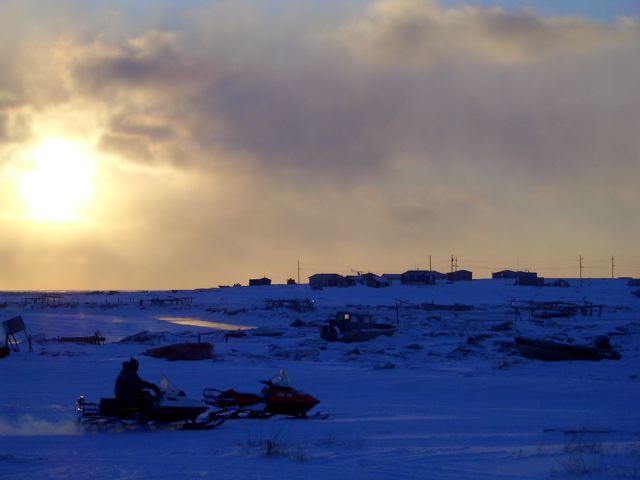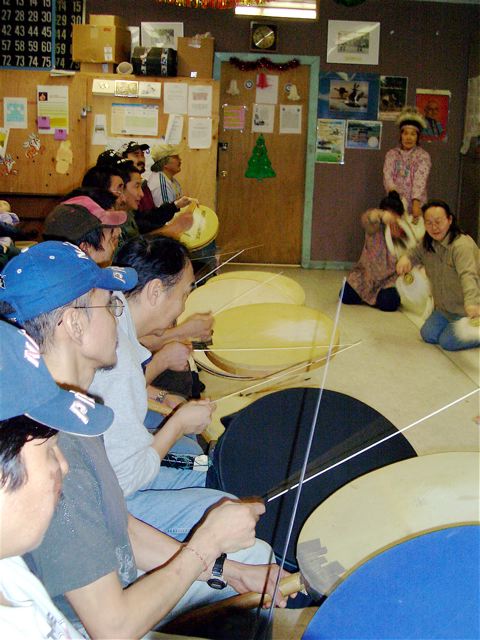This Holy Week I find myself remembering Eastertides past that I spent in pastoral service among the Yup’ik eskimo people on Alaska’s Bering Seacoast. Having been a Jesuit (lay) Volunteer fresh out of college (1981-82) in the village of Emmonak (mouth of the Yukon River, then population of 650), I began returning for seasonal pastoral service in the region as a Jesuit priest in 2000, continuing through 2009. I hope finally to return again a year from now, as part of my sabbatical. Here follows an entry from my pastoral diary, dated March 27, 2002:
I am once again on Alaska’s Bering Seacoast. This time assigned to the village of Hooper Bay, I arrived last Saturday (in time for Palm Sunday) and hope to fly out the day after Easter (weather permitting). As the crane flies, Hooper is 20 miles west of Chevak, the village I’ve served the last three times (straight shot by snowmobile in winter, that is, through May, much longer by boat in summer). I came to Hooper twice last summer to do funerals (three-day affairs for the Yup’ik people). The intriguing thing is that this longer stay is marked by the same phenomenon this time around: death rites. For the last three days I’ve been doing liturgies (along with the village elder/deacon) in the home of a 40-year-old mother whose son recklessly drove his snowmobile three weeks ago, got lost, and has never been found. Rescue volunteers found his snowmobile on the coastline 40 miles north, but no body. His tracks indicated that he’d been driving so fast as to have often been airborne. They’re still looking, and the physical and psychological strain is now overtaking many in the village. This region has the highest suicide rate per capita in the nation, mostly youth/young adults. This death has touched deep chords of anguish and even anger among the parents over how “lost” their children have become. Much of that came to a head after the Mass in the home last night. We started at 7 pm with the elder performing a 30-minute purification ritual with ayuk (incense made from a tundra shrub) and blessed owl feather (both presented to me as gifts afterward). I presided over Word and Eucharist, after which came an extended meeting. The one-room house was packed with people, including rescue volunteers and their wives from two other villages. The deacon, according to his elder status, spoke first, nearly a half-hour in Yup’ik. Then followed many other speeches and discussion in a mix of English and Yup’ik. I left well after 10 pm, quite spent. The tragic fact is that the mother of the missing youth is a widow, her husband having killed himself at age 30 some six years ago.

Then, at 4 am, banging woke me to find the public safety officer (there are no police in the villages): “Alexis H. has died. I’ll take you to the house.” My immediate reaction: “How old was he?” Relieved to learn he was an elder, I pulled myself together and accepted the snowmobile ride across the lake to spend an hour with the two elderly sisters of the 85-year-old corpse lying on their couch. As I signed with the cross Alexis’s forehead, sprinkled his body with water (reminder of his baptism), and articulated the accompanying biblical passages and prayers, my heart ached for the late-teen grandniece who, I learned, had cared for him around the clock. Words cannot express how privileged I felt to be with them in that home. The ensuing days of Masses (the Yup’iks keep vigil with the body for two days before a third-day funeral) intertwined with the parish liturgies of the Easter Triduum (Mass of the Lord’s Supper, Good Friday, Easter Vigil), making my task as a preacher a fluid one, connecting narratives of Christ’s paschal mystery traversing lives of faithful love unto death.

Dr. Bruce Morrill
Edward A. Malloy Chair of Catholic Studies
Professor of Theological Studies
